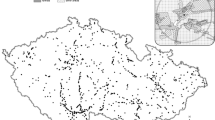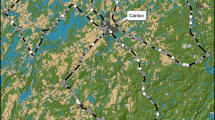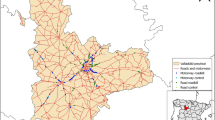Abstract
Road mortality is an increasing problem for terrestrial vertebrate conservation due to the increase of both road numbers and vehicle flow. We hypothesize that the probability of a predator being killed on the road is related to the presence of its prey adjacent to the road, which is likely to be related to the use that these predators make of road verges. We aim to identify the features of specific stretches of road where road-kills of a predator (European polecat) occur in Mediterranean landscapes, including the presence of its main prey (European rabbit) and landscape and road features. We compared 85 100 m long stretches of road where at least one road-kill was recorded with 104 stretches without any road-kill in a dry agricultural landscape in central Spain. We used regression analysis to investigate the relationship between road-kill occurrence and the features in the 67% of the cases. Road-kill stretches were characterised by greater numbers of rabbit burrows in the road verges and by higher traffic flow and speed (i.e. higher speed limit, lower proportion of heavy vehicles, wider road and lower proportion of unbroken central lines). Road-kill stretches also had more metres built over bridges and lower densities of people. We validated our best model with a dataset (the 33% of the cases) not included in its development, which correctly classified 82% of road-kill stretches and 89% of non-road kill stretches. Our results highlight the need for taking into account food resource distribution when studying causes of animal road-kills.
Similar content being viewed by others
Abbreviations
- AIC:
-
Akaike information criterion
- AICc:
-
Corrected Akaike information criterion
- IGN:
-
The Spanish national geographic institute
- PC:
-
Principal component
- PCA:
-
Principal component analysis
- UTM:
-
Universal transverse mercator coordinate system
References
Andrén H (1994) Effects of habitat fragmentation on birds and mammals in landscapes with different proportions of suitable habitat: a review. Oikos 71:355–366. doi:10.2307/3545823
Baghli A, Walzberg C, Verhagen R (2005) Habitat use by the European polecat Mustela putorius at low density in a fragmented landscape. Wildl Biol 11:331–339. doi:10.2981/0909-6396(2005)11[331:HUBTEP]2.0.CO;2
Bautista LM, García JT, Calmaestra RG, Palacín C, Martín CA, Morales MB et al (2004) Effects of weekend road on the use of space by raptors. Conserv Biol 18:726–732. doi:10.1111/j.1523-1739.2004.00499.x
Bellamy PE, Shore RF, Ardeshir D, Treweek JR, Sparks TH (2000) Road verges as habitat for small mammals in Britain. Mammal Rev 30:131–139. doi:10.1046/j.1365-2907.2000.00061.x
Birks JDS (1997) A volunteer-based system for sampling variations in the abundance of polecats (Mustela putorius). J Zool (Lond) 243:857–863
Birks JDS, Kitchener AC (1999) The distribution and status of the polecat Mustela putorius in Britain in the 1990s. The Vincent Wildlife Trust, London
Blandford PRS (1987) Biology of the polecat Mustela putorius, a literature review. Mammal Rev 17:155–198. doi:10.1111/j.1365-2907.1987.tb00282.x
Burnham KP, Anderson DR (2002) Model selection and multimodel inference. Springer, New York
Calvete C, Estrada R, Angulo E, Cabezas-Ruíz S (2004) Habitat factors related to wild rabbit conservation in an agricultural landscape. Land Ecol 19:531–542. doi:10.1023/B:LAND.0000036139.04466.06
Clarke GP, White PCL, Harris S (1998) Effects of roads on badger Meles meles populations in south-west England. Biol Conserv 86:117–124. doi:10.1016/S0006-3207(98)00018-4
Clevenger AP, Chruszcz B, Gunson KE (2003) Spatial patterns and factors influencing small vertebrate fauna road-kill aggregations. Biol Conserv 109:15–26. doi:10.1016/S0006-3207(02)00127-1
Cuesta M (1994) Bioecología de los mustélidos en los Montes de Toledo. Disseration, Universidad Complutense of Madrid
Davison A, Birks JDS, Griffiths HI, Kitchener AC, Biggins D, Butlin RK (1999) Hybridization and the phylogenetic relationship between polecats and domestics ferrets in Britain. Biol Conserv 87:155–161. doi:10.1016/S0006-3207(98)00067-6
Forman RTT, Alexander LE (1998) Roads and their major ecological effects. Annu Rev Ecol Evol Syst 29:207–231
Forman RTT, Sperling D, Bissonette JA, Clevenger AP, Cutshall DC, Dale VH et al (2003) Road ecology. Science and solutions. Island Press, Washington
Gea-Izquierdo G, Muñoz-Igualada J, San Miguel-Aynaz A (2005) Rabbit warren distribution in relation to pasture communities in Mediterranean habitats, consequences for management of rabbit populations. Wildl Res 32:723–731. doi:10.1071/WR04129
Gehrt SD (2002) Evaluation of spotlight and road-kill surveys as indicators of local raccoon abundance. Wildl Soc Bull 30:449–456
Ginsberg JR (2001) Setting priorities for carnivore conservation, what makes carnivores different? In: Gittleman JL, Funk SM, Macdonald D, Wayne RK (eds) Carnivore conservation. Cambridge University Press, Cambridge, pp 498–523
Gutzwiller KJ (ed) (2002) Applying landscape ecology in biological conservation. Springer, New York
Holm S (1979) A simple sequentially rejective Bonferroni test procedure. Scand J Stat 6:65–70
Iuell B, Bekker GJ, Cuperus R, Dufek J, Fry G, Hicks C et al (2003) Wildlife and traffic. A European handbook for identifying conflicts and designing solutions. KNNV Publishers, Delft
Klocker U, Croft DB, Ramp D (2006) Frequency and causes of kangaroo-vehicle collisions on an Australian outback highway. Wildl Res 33:5–15. doi:10.1071/WR04066
Kristiansen LV, Sunde P, Nachman G, Madsen AB (2007) Mortality and reproductive patterns of wild European polecats Mustela putorius in Denmark. Acta Theriol (Warsz) 52:871–878
Linnell JDC, Swenson JE, Andersen R (2000) Conservation of biodiversity in Scandinavian boreal forest, large carnivores as flagships, umbrellas, indicators, or keystones? Biodivers Conserv 9:857–868. doi:10.1023/A:1008969104618
Little SJ, Harcourt RG, Clevenger AP (2002) Do wildlife passages act as prey-traps? Biol Conserv 107:135–145. doi:10.1016/S0006-3207(02)00059-9
Lodé T (1994) Environmental factors influencing habitat exploitation by the polecat Mustela putorius in western France. J Zool (Lond) 234:75–88
Lodé T (1997) Trophic status and feeding habits of the European polecat Mustela putorius L. 1758. Mammal Rev 27:117–184. doi:10.1111/j.1365-2907.1997.tb00447.x
Lodé T (2003) Sexual dimorphism and trophic constraints: prey selection in the European polecat (Mustela putorius). Ecoscience 10:17–23
Lodé T, Pereboom V, Berzins R (2003) Implications of an individualistic lifestyle for species conservation: lessons from jealous beasts. C R Biol 326:S30–S36. doi:10.1016/S1631-0691(03)00024-6
Lombardi L, Fernández N, Moreno S (2007) Habitat use and spatial behaviour in the European rabbit in three Mediterranean environments. Basic Appl Ecol 8:453–463. doi:10.1016/j.baae.2006.09.004
Macdonald DW (1995) European mammals: evolution and behaviour. Harper Collins, Oxford
Malo JE, Suárez F, Díez A (2004) Can we mitigate animal-vehicle accidents using predictive models? J Appl Ecol 41:701–710. doi:10.1111/j.0021-8901.2004.00929.x
Marcelli M, Fusillo R, Boitani L (2003) Sexual segregation in the activity patterns of European polecats (Mustela putorius). J Zool (Lond) 261:249–255. doi:10.1017/S0952836903004151
Mestre FM, Ferreira JP, Mira A (2007) Modelling the distribution of the European polecat Mustela putorius in a Mediterranean agricultural landscape. Rev Ecol (Terre Vie) 62:35–47
Mitchell-Jones AJ, Amori G, Bogdanowicz W, Kryštufek B, Reijnders PJH, Spitzenberger F et al (1999) The atlas of European mammals. Academic Press, London
Moya-Laraño J, Wise DW (2007) Two simple strategies of analysis to increase the power of experiments with multiple response variables. Basic Appl Ecol 8:398–410. doi:10.1016/j.baae.2006.09.014
Palomares F (2003) Warren building by European rabbits (Oryctolagus cuniculus) in relation to cover availability in sandy area. J Zool (Lond) 259:63–67. doi:10.1017/S0952836902002960
Ramp D, Caldwell J, Edwards KA, Warton D, Croft DB (2005) Modelling of wildlife fatality hotspots along the snowy mountain highway in New South Wales, Australia. Biol Conserv 126:474–490. doi:10.1016/j.biocon.2005.07.001
Ramp D, Wilson VK, Croft DB (2006) Assessing the impacts of roads in peri-urban reserves: road-based fatalities and road usage by wildlife in the Royal National Park, New South Wales, Australia. Biol Conserv 129:348–359. doi:10.1016/j.biocon.2005.11.002
Roger M (1991) Food-habits and prey availability in the polecat Mustela putorius. Rev Ecol (Terre Vie) 46:245–261
Rondinini C, Ercoli V, Boitani L (2006) Habitat use and preference by polecats (Mustela putorius L.) in a Mediterranean agricultural landscape. J Zool (Lond) 269:213–219
Saeki M, Macdonald DW (2004) The effects of traffic in the raccon dog (Nyctereutes procyonoides viverrinus) and other mammals in Japan. Biol Conserv 118:559–571. doi:10.1016/j.biocon.2003.10.004
Schröpfer von R, Bodenstein C, Seebass C (2000) Der Räuber-Beute-Zusammenhang zwischen dem Iltis Mustela putorius L., 1785 und dem Wildkanichen Oryctolagus cuniculus (L., 1758). Z Jagdwiss 46:1–13. doi:10.1007/BF02240659
Seiler A (2005) Predicting locations of moose-vehicle collisions in Sweden. J Appl Ecol 42:371–382. doi:10.1111/j.1365-2664.2005.01013.x
Sidorovich VE (2000) The on-going decline of riparian mustelids (European mink, Mustela lutreola, polecat, Mustela putorius, and stoat, Mustela erminea) in eastern Europe: a review of the results to date and an hypothesis. In: Griffiths HI (ed) Mustelids in a modern world. Management and conservation aspects of small carnivore: human interactions. Backhuys Publishers, Leiden, pp 295–317
Sleeman DP (1988) Irish stoat road casualties. Ir Nat J 22:527–529
Spellerberg IF (1998) Ecological effects of roads and traffic, a literature review. Glob Ecol Biogeogr 7:317–333. doi:10.1046/j.1466-822x.1998.00308.x
Trombulak SC, Frissell CA (2000) Review of ecological effects of roads on terrestrial and aquatic communities. Conserv Biol 14:18–30. doi:10.1046/j.1523-1739.2000.99084.x
Van Langevelde F, Jaarsma CF (2004) Using traffic flow theory to model traffic mortality in mammals. Land Ecol 19:895–907. doi:10.1007/s10980-004-0464-z
Virgós E (2001) Relative value of riparian woodlands in landscapes with different forest cover for medium-sized Iberian carnivores. Biodivers Conserv 10:1039–1049. doi:10.1023/A:1016684428664
Virgós E (2002) Mustela putorius, Linneaus, 1758. In: Palomo LJ, Gisbert J (eds) Atlas de los Mamíferos Terrestres de España. Dirección General de Conservación de la Naturaleza-SECEM-SECEMU, Madrid, pp 262–265
Virgós E (2003) Association of the polecat Mustela putorius in eastern Spain with montane pine forests. Oryx 37:484–487. doi:10.1017/S0030605303000863
Virgós E, Cabezas-Díaz S, Lozano J (2007a) Is the wild rabbit (Oryctolagus cuniculus) a threatened species in Spain? Sociological constrains in the conservation of species. Biodivers Conserv 16:3489–3504. doi:10.1007/s10531-006-9054-5
Virgós E, Cabezas-Díaz S, Lozano J (2007b) Mustela putorius, Linneaus, 1758. Ficha Libro Rojo. In: Palomo LJ, Gisbert J, Blanco JC (eds) Atlas y Libro Rojo de los Mamíferos Terrestres de España. Dirección General de Conservación de la Naturaleza-SECEM-SECEMU, Madrid, pp 297–298
Yanes M, Velasco JM, Suárez F (1995) Permeability of roads and railways to vertebrates: the importance of culverts. Biol Conserv 71:217–222. doi:10.1016/0006-3207(94)00028-O
Zabala J, Zuberogoitia I, Martínez-Climent JA (2005) Site and landscape features ruling the habitat use and occupancy of the polecat (Mustela putorius) in a low density area, a multiscale approach. Eur J Wildl Res 51:157–162. doi:10.1007/s10344-005-0094-z
Acknowledgements
We are very grateful to I. Cardiel, R. Jiménez, P.M. García, D. Martínez, O. Frías, J.A. Calvo, J.A. Lemus for their help in the field. We thank F. Valera, R. Václav, E. Virgós, J. Moya-Laraño, G. Hernández-Milián, J. Birks, D.P. Sleeman and an anonymous referee for their helpful suggestions. J. Moya-Laraño, Mark T. Bulling and B. Nicholls checked the English. Traffic data were provided by M. Vidal (Junta de Comunidades de Castilla-La Mancha), A. J. Cervantes and J. Cobas (Diputación de Toledo) and A. Oliver (TELVENT). The Dirección General del Medio Natural of Toledo Province (Junta de Comunidades de Castilla-La Mancha) partially supported our research by means of TO-01-03 and TO-01-04.
Author information
Authors and Affiliations
Corresponding author
Appendix 1
Appendix 1
The results of the principal component analysis run prior to the development of the models in order to investigate the multicollinearity among independent variables
Variable | PC1 | PC2 | PC3 | PC4 | PC5 | PC6 |
|---|---|---|---|---|---|---|
DRY | 0.421258 | −0.132407 | 0.230408 | −0.839526 | −0.030065 | −0.007502 |
NON_CULT | 0.219066 | 0.230037 | −0.097520 | 0.809347 | 0.067512 | 0.218732 |
OTHER | −0.820769 | −0.107831 | −0.182926 | 0.110852 | −0.043183 | −0.257860 |
WOODY | 0.077028 | 0.633344 | 0.101267 | 0.369508 | 0.224009 | −0.143506 |
M_BURROW | −0.242736 | 0.066876 | 0.115347 | −0.127656 | −0.071437 | −0.805967 |
N_BURROWS | 0.147825 | 0.027444 | −0.132319 | 0.182981 | 0.218188 | 0.786171 |
TOWN | 0.263878 | −0.006824 | 0.377190 | 0.529965 | −0.054079 | 0.212921 |
HOUSE | 0.230201 | −0.354476 | 0.494688 | 0.072375 | 0.239758 | 0.215083 |
RIVER | 0.126340 | −0.286418 | 0.083116 | 0.025225 | 0.384410 | −0.539122 |
SPEED | 0.854368 | 0.029600 | −0.110758 | 0.169153 | 0.018011 | 0.078418 |
TRAFFIC | −0.161921 | 0.115909 | −0.762606 | 0.150385 | 0.265780 | 0.115479 |
HEAVY | −0.085134 | 0.117805 | 0.647747 | 0.082747 | −0.053125 | −0.223346 |
WIDTH | 0.431084 | −0.088140 | −0.617466 | 0.248435 | −0.061471 | 0.129852 |
PASS | 0.008378 | −0.750472 | 0.007064 | −0.033088 | 0.118274 | −0.143836 |
EMBANKMENT | 0.126225 | 0.086953 | −0.269614 | −0.031974 | 0.783474 | 0.109793 |
BRIDGE | 0.043028 | 0.775742 | −0.042387 | 0.075463 | 0.153974 | 0.017040 |
UNBROK_LINE | −0.443517 | 0.143221 | 0.132539 | 0.129783 | 0.563282 | 0.069696 |
Rights and permissions
About this article
Cite this article
Barrientos, R., Bolonio, L. The presence of rabbits adjacent to roads increases polecat road mortality. Biodivers Conserv 18, 405–418 (2009). https://doi.org/10.1007/s10531-008-9499-9
Received:
Accepted:
Published:
Issue Date:
DOI: https://doi.org/10.1007/s10531-008-9499-9




